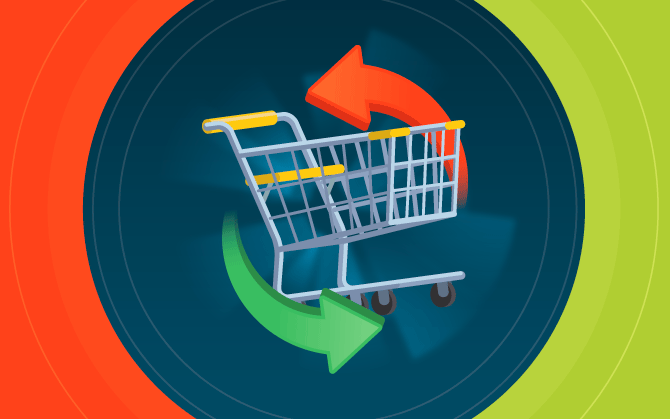
Learn more about a customer’s purchasing cycle and boost your sales
The 5 steps of the customer’s journey.

What will we see in this post
Online purchases are no longer considered a trend and its share of the market has been growing steadily on most countries around the world.
But, in order to be successful in this market, it’s important that you know your persona really well, as well as follow and guide the lead throughout their purchasing cycle.
Several factors need to be considered when developing this strategy, from the content presented to the service offered.
Is creating specific approaches for each step of the costumer’s journey hard work? We know that it is, but we’re here to make this process simpler.
In this post, you will better understand the purchasing cycle concept, get to know the main advantages of considering this in your strategies and discover each of the steps of the online costumer journey.
What is the customer’s purchasing cycle?
Also known as the Buyers’ journey, the purchasing cycle is the path taken by customers from the first contact with the brand to the after-sales.
This “mapping” of the purchase originates from the understanding that all points of contact that a person has with a brand can make the difference — either positively or negatively.
The cycle is divided into 5 steps:
- Awareness;
- Consideration;
- Purchase;
- Retention;
- Advocacy.
Knowledge of each of these steps impacts the planning of content, as well as the CRM (Costumer Relationship Management), and can also influence sales.
Why is it important to understand the purchasing cycle?
The production of online content has created a new form of relationship between brands and customers, but different factors influence this communication.
Do the customers know the brand? Are they familiar with the products or services being offered?
Sometimes, those who want a product, for example, aren’t those who can afford it, and the communication material needs to take this into account.
Knowing the purchasing cycle is key so that communication doesn’t have any gaps in any of the different points of contact.
The content also needs to be well thought out according to this journey. After all, you aren’t going to offer an ebook and ask for any type of registration (however simple it may be) to someone who has just gotten to know your brand, are you?
Another advantage of studying the purchasing cycle is that is allows for a better integration between the marketing and sales teams, in addition to facilitating the marketing automation work.
Leads need to be nurtured enough so that a product can be actually offered. This practice reduces the cost of acquisition per customer, can help reduce shopping cart abandonment rates and consequently, increase a company’s return on investment.
What are the phases of the purchasing cycle?
As we’ve explained, the approach and content presented to customers vary in each purchasing cycle step. Learn more about them below!
Awareness
The first contact between a brand and a potential customer takes place when the person probably doesn’t even know they have a problem that can be solved by a specific product or service.
At this state, the initial searches are made referring to this issue. Because of this, educational posts on blogs are a good investment for content in this step of the purchasing cycle.
Consideration
During the consideration phase, customers have some familiarity with your brand, as well as a certain awareness of their problem.
In many cases, they already know that your products can help them, but they are searching for more information about possible competitors and comparing the offers.
The content presented during this step can (and should) make direct reference to your brand.
An interesting point here is to be a bit more of a salesperson and show your advantages in comparison with your competitors on different fronts: quality of the product, customer service, payment methods, etc.
More complex content and invitations to download an ebook or sign up for your newsletter can also be introduced, considering that during this phase there is already an interest in becoming a lead.
Purchase
During this step, potential customers become a consumer of your brand.
You now have access to other information about this person — such as their phone number, email, preferred method of payment, etc. —, and you need to use them in your favor during the following steps.
That’s right. The work doesn’t end even after the purchase is completed!
Retention
Retention is when your brand’s after-sales needs to shine!
During this step, customers analyze their experience as a whole, from the service to the quality of the product they have at hand.
For example, how do you stay in touch with these leads and encourage them to continue making purchases on your website?
Contact via email or SMS can work well during this step. You can send a customer satisfaction survey, present products related to the ones initially purchased or offer coupons and discounts to build customer loyalty.
Advocacy
Also known as advocacy, this step is the ultimate goal when you invest in strategies that consider customers’ purchasing cycle.
It is at this moment that customers are considered brand ambassadors— not only are they loyal, but they also advocate and encourage other people to buy your products.
Why should you monitor the purchasing cycle?
In conclusion, we need to reinforce the importance of monitoring the strategies involved in all these steps.
User behavior on the internet is quite fluid, so in certain situations, the customer’s journey doesn’t necessarily follow all the purchasing cycle steps — or doesn’t follow them in the order presented here.
However, it’s important that you get to know all of them so that you can create attractive materials, convert and build the loyalty of your audience all the time. From this, the monitoring of the results will ensure that your leads are being properly nurtured.
Do you see how understanding the purchasing cycle can make all the difference in your business? Are you eager to roll up your sleeves and prepare the best content for your customers and potential customers according to this journey? We certainly hope so!






